Australia
Greeted With Raptorous Applause: Ford Ranger Raptor
Anticipation can lead to either joy or disappointment. When it comes to the long anticipated Ford Performance Vehicles Ranger Raptor, so far it’s looking more of the former. Here’s what we know.
Engine: a 2.0L diesel provides peak power of 157kW and 500Nm (1750 – 2000 rpm)and means the Raptor will have plenty of bite, thanks to a bi-turbo system that will drink from a 80L tank. It’s EURO V compliant at 212 gr/km, will be offering a 8.2L/100 km fuel economy for the combined cycle, and see a top speed of 170 km/h. with a 0-100 km/h time of just over ten seconds. Good figures from a 2.3 tonne machine before fuel and passengers. The transmission is a ten speed (yes, ten speed) automatic with ratios picked to ensure quicker shifts and to be as close as possible to the right gear for the throttle setting. It’s good enough for a 2500 kilo towing (braked) figure. Chassis: 283mm of ground clearance, a broader track than the standard Ranger at 1710mm front and rear, and 285/70/17 wheels & BF Goodrich All Terrain rubber, specially made for Raptor, combine with composite material front fenders and a bumper with integrated LED fog lamps to provide an assertive on and off road presence. Turning circle is a tight 12.9 metres. The load tray is 1743mm in length and 1560mm in width on a 5398mm long body. Maximum width is2180mm with the mirrors out.
Chassis: 283mm of ground clearance, a broader track than the standard Ranger at 1710mm front and rear, and 285/70/17 wheels & BF Goodrich All Terrain rubber, specially made for Raptor, combine with composite material front fenders and a bumper with integrated LED fog lamps to provide an assertive on and off road presence. Turning circle is a tight 12.9 metres. The load tray is 1743mm in length and 1560mm in width on a 5398mm long body. Maximum width is2180mm with the mirrors out. Inside: a bespoke interior with blue stitching, leather highlights and “technical suede” for extra lateral grip, a rejigged look to the instrument bezel, and perforated leather sections on the steering wheel make for a classy cabin environment.
Inside: a bespoke interior with blue stitching, leather highlights and “technical suede” for extra lateral grip, a rejigged look to the instrument bezel, and perforated leather sections on the steering wheel make for a classy cabin environment. Ride and Drive: There’s a Terrain Management System, TMS, which includes a Baja mode. This sharpens up the engine and transmission and blunts the intrusion of the traction control to give a driver a real off-road experience. It’s a pair of Macpherson struts up front and Ford’s tried and true Watts linkage at the rear.
Ride and Drive: There’s a Terrain Management System, TMS, which includes a Baja mode. This sharpens up the engine and transmission and blunts the intrusion of the traction control to give a driver a real off-road experience. It’s a pair of Macpherson struts up front and Ford’s tried and true Watts linkage at the rear. Brakes: Plenty of swept area on the discs means plenty of stopping power.332mm x 32mm up front and 332mm x 24mm at the rear meet a 54mm caliper. They’re bolted to Position Sensitive Dampers that provide, at full extension and compression, a higher level of rebound force. Mid range damping force is specifically tuned for comfort during normal driving.
Brakes: Plenty of swept area on the discs means plenty of stopping power.332mm x 32mm up front and 332mm x 24mm at the rear meet a 54mm caliper. They’re bolted to Position Sensitive Dampers that provide, at full extension and compression, a higher level of rebound force. Mid range damping force is specifically tuned for comfort during normal driving.
Extras: A “breadcrumb” feature in the satnav allows drivers to backtrack the way they came when in areas that may not be included in the mapping system. There’s a Rollover Mitigation System to deal with the 32 degree approach, 24 degree departure, and 24 degree break over angles.
DRIVER ASSISTANCE AND CONVENIENCE TECHNOLOGIES
Adjustable speed limiter, Auto lighting, 25W HID headlights with LED Daytime Running Lamps, LED Fog Lamps, cruise control, Electronic Automatic Temperature Control, Electronic Stability Control, Passive Entry Passive Start (PEPS), Rear Parking Sensors, Lane Departure Warning, Lane Keep Assist, Hill Start Assist (HAS), Hill Descent Control (HDC), ESC system with Trailer Sway Control (TSC), Load Adaptive Control (LAC), Roll Over Mitigation (ROM), Traffic Sign Recognition, Steering Wheel Paddle Shifters, Part time 4×4 with Terrain Management System, Unique Transmission Calibration and “Live in Drive” Functionality, rain sensing wipers, rear view camera, Roll Stability Control
SYNC 3 with touchscreen navigation, Auto Start/Stop.
EVs, Power Bills and Emissions

How do we change a system employed by government? If we went cold turkey on many of our traditional national policies the flow on effects throughout the public and business sectors would be ruinous. If you believe the headlines which state that traditional motor vehicles are heading for a cliff edge where there will be no more fossil fuels available to power them, and that the environment will be so much the better without vehicles that are powered by conventional fossil fuels, then things look pretty dismal. But is this actually so?
There are numerous countries around the world that have their special governmental team of policymakers pushing for electric vehicles (EVs) to be subsidised and made easier for those who can afford an expensive EV to buy one. Across the ditch the New Zealand Labour/Green government are creating a fast track for EV purchase in the hopes to lessen greenhouse emissions and keep NZ green. And in America they have recently brought in policy that reduces the initial purchase price of an EV by up to $7500 USD. Of course, the subsidizing is paid for by the tax payer. Those who cannot afford to buy a new electric vehicle pay for the privileges that the wealthier EV owners enjoy – like free use of public charging stations and preferential access to carpool lanes. What about the grand schemes and plans of making some American States totally EV and thus pronouncing the ban of all internal combustion vehicles by 2040 (California). Is this really fair?
Could this thinking and ideology be the motivation behind EVs in Australia? How could the typical Australian on an average wage manage a law that states that you must drive a new and expensive EV by 2040? By the way, we’ll also use your current taxes to help the wealthy buy an EV quickly (and enjoy its benefits) while you struggle to put the food on the table, let alone by an EV!
Let’s also remember that most of Australia’s electricity is made by coal and other natural resource plants. A large fleet of EVs across Australia will draw down on the current available power supplies very heavily. But wait, I know, we could use people’s current taxes to build more expensive cleaner power plants and provide bigger, better power networks! That will make Australia a better place. Power companies will enjoy the profits and will be sure to put the price of power up once electricity comes in short supply.
Hang on! Are electric vehicles really as great as they claim to be? Supporters of the EV suggest that EVs will reduce air pollution and tackle climate change. But will they? (Climate change is another issue – and one that many can make plenty of money, too) It’s evident that a new vehicle powered by the modern conventional internal combustion engine is, in fact, way more pollutant-free than one might tend to think. Extracting Lithium and other materials for batteries has an environmental impact of its own.
The appropriate comparison at governmental levels for evaluating the benefits of all those new electric vehicle subsidies, mandates and ideologies should be the difference between an electric car and a new petrol-or-diesel-car. New internal combustion engines are very clean and emit only about 1 percent of the pollution that older vehicles did back in the 1960s. New innovations on internal combustion engines continue to improve these engines and their efficiency and cleanliness.
When we consider EVs, and their large appetite for electricity, the energy to power them has to come from somewhere. Cars are charged from the nation’s electrical grid, which will mean that they’re only as “clean” as Australia’s mix of power sources. An environmental impact in the mining of the lithium, cobalt, and nickel that go into car batteries is evident. Extracting Lithium is actually not so bad; most of it is extracted from brines that are evaporated by the sun, but it has a sizeable carbon and physical footprint. We have a long, long way to go before the production of electricity for the main grid looks as green and as clean as an EV appears.
What’s the inexpensive answer?
Mercedes-Benz X-Class For The Tradies Is Here.
Along with German sibling Volkswagen, Mercedes-Benz now offers a four door utility vehicle. Called the X-Class it’s got a starting price of $45,490 plus on roads. With an effective trickle style media campaign underway there’s already over 8000 registrations of interest in their new vehicle. As is to be expected, M-B will offer an almost bewildering range of variants. There’s will be a choice of two models called the X 220d and X250d, two diesel engines offering either 120kW or 140kW, a six speed manual for each or a seven speed auto for the 250d.
The 220d will be given either a rear wheel or all wheel drive system, with the 250d coming in AWD only. A high output V6 will be available by the end of 2018, with 190kW and 550Nm of torque.
There will be three trim levels: Pure, Progressive, and Power, designed to appeal to three distinct lifestyles and working groups. Underneath will be the tried and true, and fettled for Australian roads, double wishbone front and multi-link rears, with both ends riding on coil springs. This aims to provide a harmonious balance of safety with any load and a comfortable ride.
Safety won’t be an issue with the X-Class receiving a five star ANCAP rating thanks to seven airbags, Autonomous Emergency Braking, Lane Keeping Assist, plus a 360 degree camera in the Power and optionable on the Progressive. It’ll have a significant on-road presence with a 5340mm length, 1920mm width and 1829mm height. The front end features a stand-out Mercedes-Benz emblem inside a twin louvre grille, a M-B family look to the lower front bar, and a powerful stance at the rear.The tray will hold a standard Australian spec pallet and towing of up to 3500 kilograms is factored in. Whilst working hard it’ll cosset driver and passengers in three trim levels inside including two leather and two roof lining colours.
It’ll have a significant on-road presence with a 5340mm length, 1920mm width and 1829mm height. The front end features a stand-out Mercedes-Benz emblem inside a twin louvre grille, a M-B family look to the lower front bar, and a powerful stance at the rear.The tray will hold a standard Australian spec pallet and towing of up to 3500 kilograms is factored in. Whilst working hard it’ll cosset driver and passengers in three trim levels inside including two leather and two roof lining colours. The Pure will be aimed at the working driver and will roll on 17 inch steel wheels. They’ll be able to access media via a seven inch touchscreen. The Progressive driver has 17 inch alloys, colour coded bumpers, heat insulating glass in the windscreen, and Garmin integrated navigation through the seven inch touchscreen.
The Pure will be aimed at the working driver and will roll on 17 inch steel wheels. They’ll be able to access media via a seven inch touchscreen. The Progressive driver has 17 inch alloys, colour coded bumpers, heat insulating glass in the windscreen, and Garmin integrated navigation through the seven inch touchscreen. Power drivers will have their new ute fitted with 18 inch alloys, man made leather interior, parking assist via M-B’s PARKTRONIC system, and an eight speaker digital audio system.
Power drivers will have their new ute fitted with 18 inch alloys, man made leather interior, parking assist via M-B’s PARKTRONIC system, and an eight speaker digital audio system.
A range of option packs will be available across the range for the 2018 Mercedes-Benz X-Class.
https://www.facebook.com/MercedesBenzVansAustralia/ and @mercedesbenzvans_au on Instagram can be followed for more information as well as contact Mercedes-Benz dealerships.
The Focus Is On The New From Ford.
Ford Australia will bring the most advanced, highly equipped and freshly styled Ford Focus to Australian customers in late 2018. The new German-made Ford Focus will bring the latest safety, technology, and European sophistication to more Australians looking for a dynamic and practical passenger car.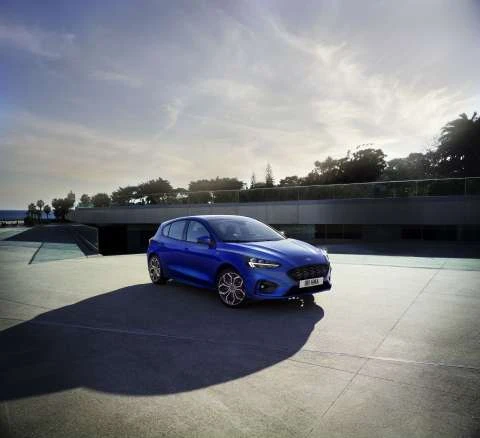 Ford Australia CEO and President, Graeme Whickman said: “We already enjoy highly-sophisticated and praised Fords from Europe, which include the current Focus ST and Focus RS models – now, our state of the art plant in Germany will be the single-source for the entire Focus range.”
Ford Australia CEO and President, Graeme Whickman said: “We already enjoy highly-sophisticated and praised Fords from Europe, which include the current Focus ST and Focus RS models – now, our state of the art plant in Germany will be the single-source for the entire Focus range.”
The first vehicle to be built on Ford’s clean-sheet C2 global platform, the new Ford Focus sports a sophisticated new chassis with advanced driving technologies with the goal of providing an energetic, engaging and rewarding fun-to-drive experience with increased cabin and powertrain refinement.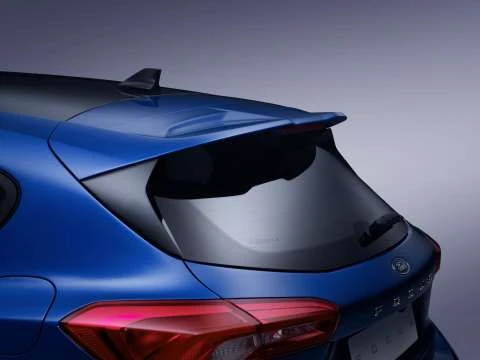 The all-new Ford Focus continues the tradition of being a groundbreaking, standard setting vehicle in terms of safety, technology and value for money by offering a host of advanced features in an stylish package. Focus will have Autonomous Emergency Braking with Night-time Pedestrian and Cyclist Detection as standard across the range. This technology is designed to detect people in or near the road ahead, or who may cross the vehicle’s path. The system automatically applies the brakes if it detects a potential collision and the driver does not respond to warnings; is now also designed to detect cyclists and functions in the dark using light from the headlamps.
The all-new Ford Focus continues the tradition of being a groundbreaking, standard setting vehicle in terms of safety, technology and value for money by offering a host of advanced features in an stylish package. Focus will have Autonomous Emergency Braking with Night-time Pedestrian and Cyclist Detection as standard across the range. This technology is designed to detect people in or near the road ahead, or who may cross the vehicle’s path. The system automatically applies the brakes if it detects a potential collision and the driver does not respond to warnings; is now also designed to detect cyclists and functions in the dark using light from the headlamps.
Focus will also come standard with a Rear wide-view camera, offering a near-180 degree view to the vehicle’s rear for improved visibility when reversing from parking spaces or driveways. Focus also introduces optional features previously only seen on high-end offerings, such as Adaptive Cruise Control (ACC) now enhanced with Stop & Go for effortlessly negotiating stop-start traffic. ACC with Stop & Go helps the Focus maintain a comfortable driving distance from vehicles ahead and adjusts the vehicle speed using information from the on-board navigation system or as it senses changes in traffic conditions. ACC works at speeds up to 200km/h.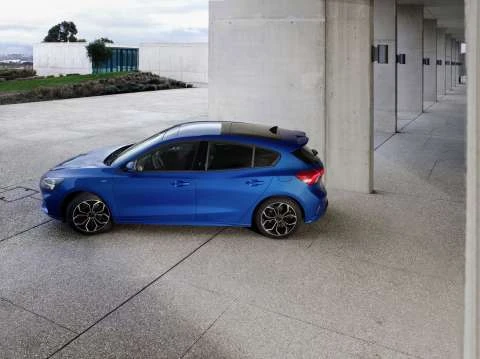 The new optional Stop & Go feature is designed to bring the vehicle to a complete halt when it detects stopped traffic using up to 50 per cent of total braking force, and automatically pull away if the stopping duration is less than three seconds. For stopping durations greater than this, the driver can push a steering wheel button or gently apply the accelerator to pull away.
The new optional Stop & Go feature is designed to bring the vehicle to a complete halt when it detects stopped traffic using up to 50 per cent of total braking force, and automatically pull away if the stopping duration is less than three seconds. For stopping durations greater than this, the driver can push a steering wheel button or gently apply the accelerator to pull away.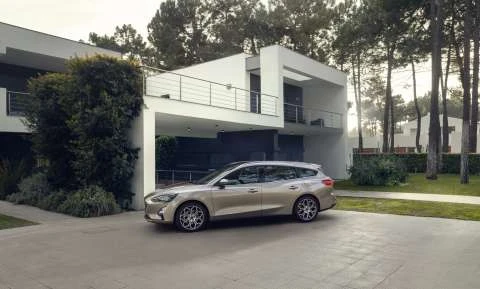 The Ford Focus will offer a choice of fuel efficient and advanced engines, as well as a new quick-shifting eight-speed torque-converter automatic transmission. Two engines will be the core of the Focus range; an entry-level 1.5-litre three-cylinder engine and a new 1.5-litre EcoBoost. The EcoBoost 1.5-litre is a turbocharged three-cylinder that develops high torque at low rpm for greater drivability, with advanced construction for improved efficiency. A combination of port fuel injection and direct fuel injection helps deliver high power and responsiveness alongside enhanced fuel-efficiency, with a particular increase in fuel-efficiency under light engine loads. This is further enhanced by Ford’s industry-first cylinder deactivation application for a three-cylinder powerplant.
The Ford Focus will offer a choice of fuel efficient and advanced engines, as well as a new quick-shifting eight-speed torque-converter automatic transmission. Two engines will be the core of the Focus range; an entry-level 1.5-litre three-cylinder engine and a new 1.5-litre EcoBoost. The EcoBoost 1.5-litre is a turbocharged three-cylinder that develops high torque at low rpm for greater drivability, with advanced construction for improved efficiency. A combination of port fuel injection and direct fuel injection helps deliver high power and responsiveness alongside enhanced fuel-efficiency, with a particular increase in fuel-efficiency under light engine loads. This is further enhanced by Ford’s industry-first cylinder deactivation application for a three-cylinder powerplant.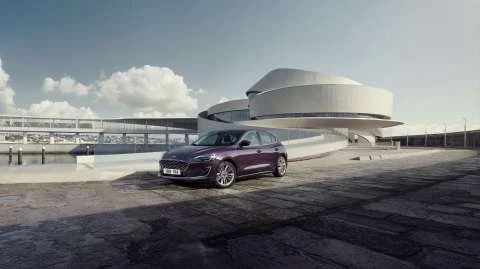 Mated to this engine is an intelligent eight-speed torque-convertor automatic transmission. This quick shifting and intuitive transmission features Adaptive Shift Scheduling (ASS). ASS identifies hard cornering, uphill and downhill gradients and adjusts the gearshifts accordingly, resulting in a more stable, engaging and refined driving experience.
Mated to this engine is an intelligent eight-speed torque-convertor automatic transmission. This quick shifting and intuitive transmission features Adaptive Shift Scheduling (ASS). ASS identifies hard cornering, uphill and downhill gradients and adjusts the gearshifts accordingly, resulting in a more stable, engaging and refined driving experience.
More details about the forthcoming Ford Focus including pricing will be released closer to the expected launch date.
With thanks to Ford Australia.